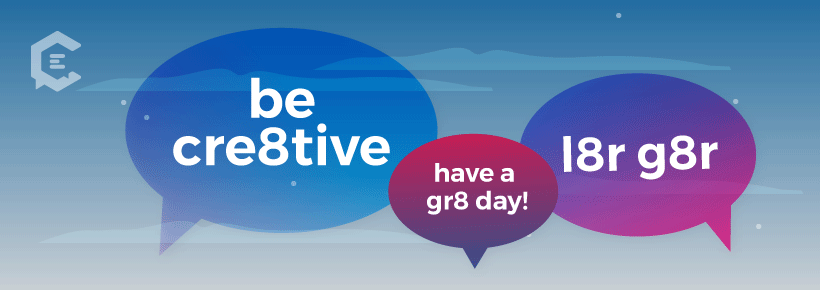We live in exciting and dynamic times, from a linguistic perspective. Not only have the grammar and style rules of 200 years become almost obsolete overnight, but emoji is (according to some industry experts, including the Trello editors) the fastest-spreading language, snatching words at an alarming rate. More people understand emoji than English or Chinese — and the greatest thing about it is the way it crosses language barriers even though every culture has subtly different emoji style norms.
But happy faces in cowboy hats and sunglasses are just one element of a shift away from words. It’s almost certain that more people today know how to make a social media graphic on Canva than know how to diagram a sentence. And knowing the difference between you’re and your is a highly charged ideological issue, not a matter of junior high-level education.
Are professional content creators nervous? Yes, they are. But do they also kind of enjoy the new wild frontier of English-meets-emoji? Some of them actually do — and it isn’t just the younger ones.
We surveyed 50+ professionals between the ages of 21 and 65 — of which 85% were in the 25-54 median. And here are some highlights of what we found.
Emoji
More than half of people surveyed think that it’s fine to use emoji in professional social media copy. Whether repping brands, professional services or legacy publications, the majority vote says to dropping ‘s, ‘s and ‘s in Instagram captions.
- 19% survey respondents say that emoji are never okay in business correspondence.
- Which means, more than 80% approve of using them for emphasis or emotion somewhere within professional copy.
- 13% of respondents wouldn’t use emoji in any kind of published copy, but think it’s okay to use them in business correspondence such as emails.
Cre8tive Spelling
When asked how they felt about intentional misspellings in copy, the majority of respondents responded strongly negative. More than 41% of content professionals cannot even look at intentionally misspelled words without cringing, even if it’s obviously done for effect. (Oh hai! Dose this bother u?)
- While 26% of survey respondents find creative misspellings to be funny when done in a clever way, less than 8% trust their team to try it out for the public.
- About 23% find this tactic “nails on a chalkboard” annoying, but acknowledge that it probably is effective with the right audience.
- Only one of all the survey responses truly, srsly luvs it whenever ppl do this.
Sloppy spelling
Contrary to what drunk uncles and random high school acquaintances on Facebook would have you believe, a misplaced apostrophe is not a sign of higher intelligence or maturity. While not all our survey participants will get in a social media fight over it, 91% of them are bothered by sloppy typos and spelling.
- 10% think that a sloppy typo in professional copy is a firing offense.
- However, another 10% thinks that anyone who gets annoyed by a typo needs to stop being uptight.
- Although only 15% of content professionals will publicly call out a misspelling or typo when they see it in professional content, another 17% absolutely loves to watch from the sidelines when someone gets called out.
The graphic takeover
On Twitter and Snapchat, GIFs and videos are replacing text altogether. And over on Instagram, text captions are a choice but not a must. Of all the recent changes to content norms, this is the most threatening to a content writer’s job security. Yet, the same percentage of survey respondents (28%) felt excited about this enormous style change as nervous for their professional future.
- Only one person confessed to actually using the Snapchat puppy ear filter as a profile pic. (But we’re pretty sure a few more do and just don’t admit to it.)
- Nearly a quarter of people surveyed is taking a proactive approach, and learning how to edit video, create Instagram stories, and make GIFs and graphics.
- 17% of our group just wants to cry at the steady erosion of copy.
What’s next?
We asked everyone to predict what would happen to their role by the year 2028. The most common fear was that AI (artificial intelligence) will replace the more basic communication tasks — but many people are optimistic that skilled content strategists and wordsmiths will be a more valuable resource when allowed to step back from tinkering with day-to-day tasks.
Here’s a selection of the responses:
“Content strategy will be a fully baked intersection of all media and communications forms, becoming more knowledge strategy than simple content.”
“Creating more Insta stories and writing in microcopy format.”
“Outside of social media, professional communication is alive and well. Information will still need to be organized, communicated, accessed, searched etc. Probably with better tools.”
“Probably AI will be able to handle most of what I do today.”
“Because everything is cyclical, hopefully I’ll be soaring as an editorial and content consultant for brands looking to restore and elevate quality.”
“Phased out, baby.”
“ I hope to be settled down a bit and consulting more, helping in-house teams communicate better — probably from my flying car.”
“There’s still a place for print. There will always be a new social media platform and editors/writers will need to roll with the punches and write or ’emoji’ as appropriate to the audience they’re trying to capture.”
“A robot will be doing my job.”
“In ten years only the most senior people will be allowed to communicate in text, because it is so powerful. I intend to be one of them.”
Our survey participants
The survey was posted on LinkedIn, Twitter, and eight professional Facebook groups ranging from professional social media managers to bloggers to veteran lifestyle journalists to PR professionals. People of all experience and educational levels were encouraged to participate. All responses were anonymous.
Job titles of respondents included:
- Creative Director
- Managing Editor
- Professor of Journalism
- SVP, Publicity
- Agency Principal
- Account Executive
- Social Media Strategist
- VP Digital Strategy
- Freelance Writer/Editor
- Marketing Communications Agency Owner







